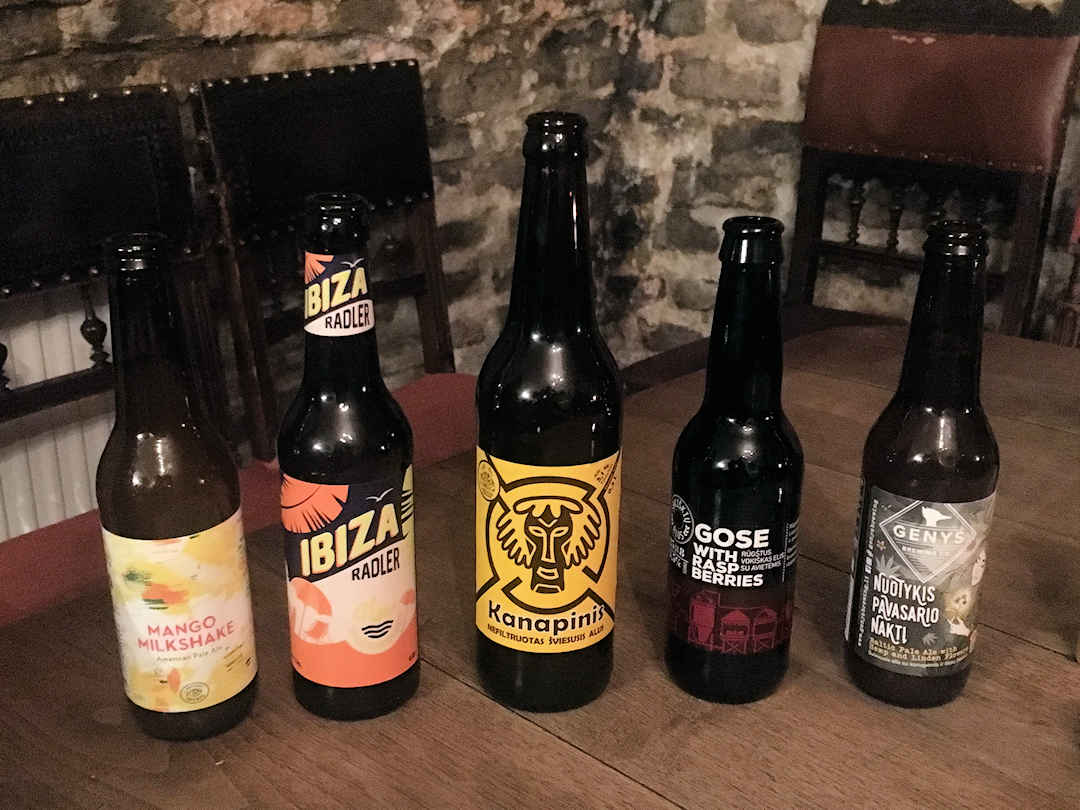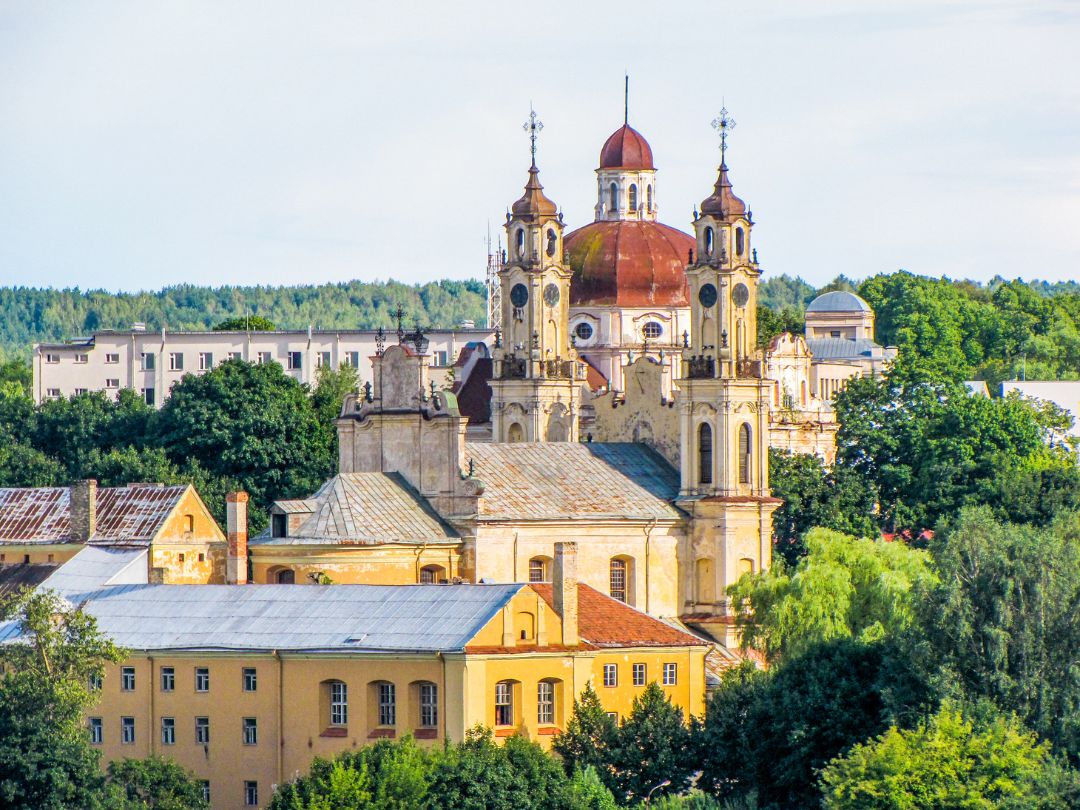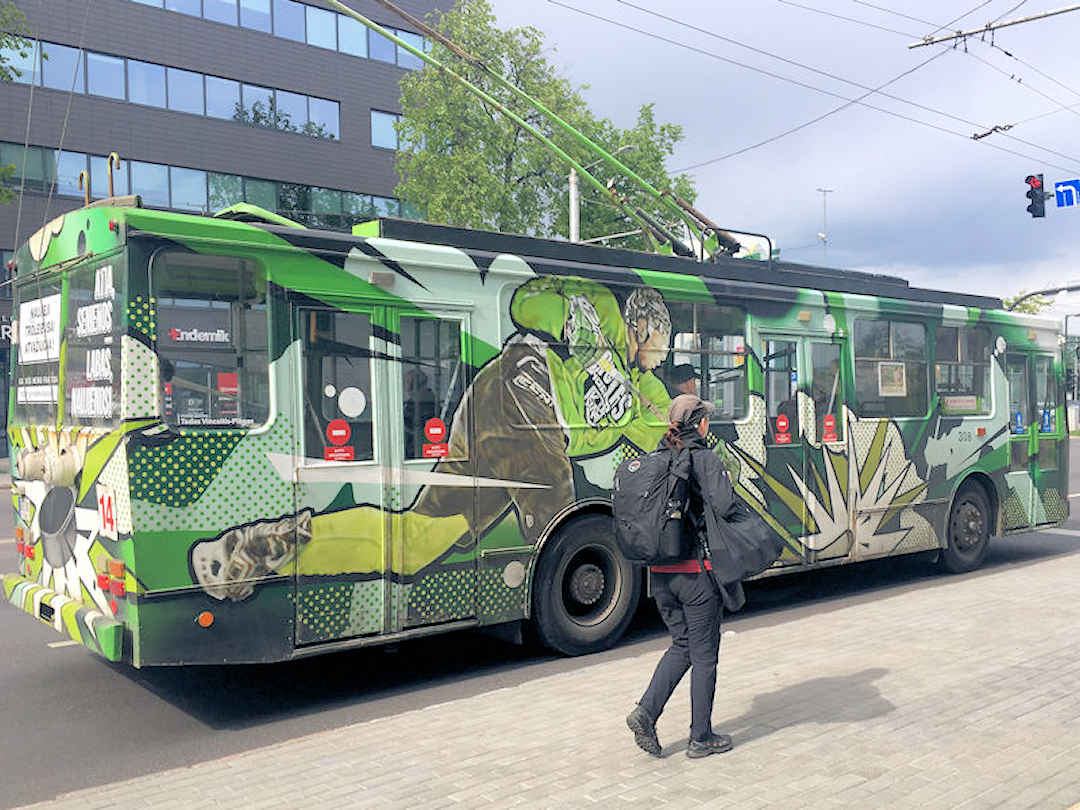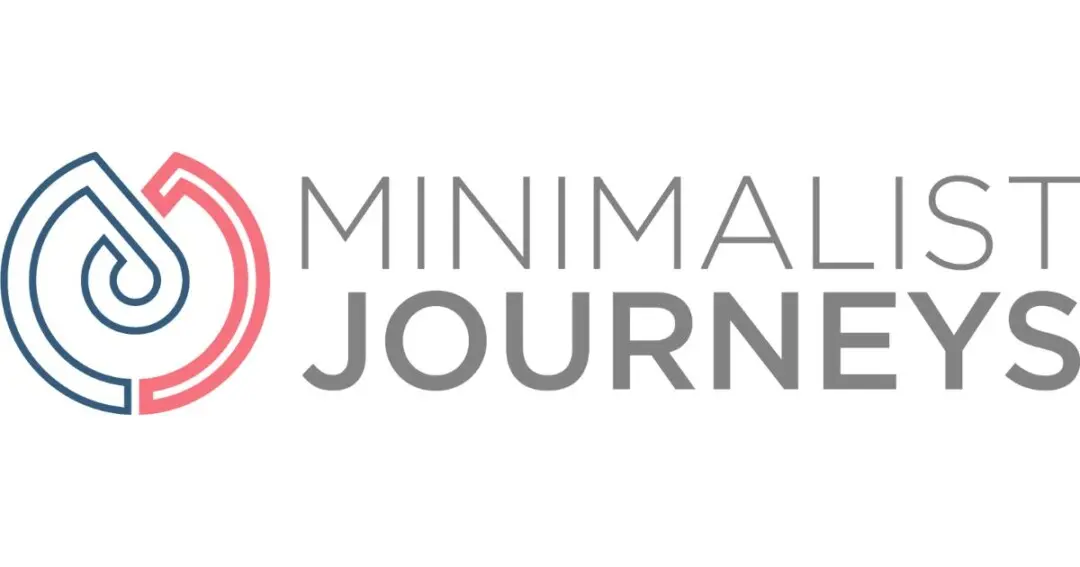This article may contain links to products and services we use and recommend. We may receive compensation when you click on links to those products. For more information, see our Disclosure Policy.
Lithuania is one of the three Baltic countries we visited recently. Sandwiched between the Baltic Sea and almighty Russia, Lithuania, Latvia and Estonia have a reputation for being affordable destinations, especially if compared with more established Western European countries or Scandinavia. So, how much does it cost to visit Lithuania?
Our daily travel expenses in Lithuania were EUR39.40 / USD44.14 per person per day. Our budget is USD50.00, so we were well under. As we explored Lithuania, we divided our time between the capital Vilnius (three nights), its second-biggest city Kaunas (also three nights), and Siauliai (one night).
Travel Cost Assumptions
When reading this article, please note that our travel costs are based on a couple travelling together. We are independent, budget-conscious travellers, researching and organising our itineraries using our go-to travel planning tools.
Our travel style is reasonably consistent wherever we go, which is excellent when you want to compare travel costs between destinations and over time:
- Accommodation: We usually stay in self-catered accommodation (homestays, locally owned guesthouses, hostels and short-term rentals) - in our room with (preferably) a private bathroom, though the kitchen and other areas may be shared.
- Dining and Groceries: We usually eat two meals a day at home. But we like to eat out once a day or at least every few days (and prefer locally owned restaurants and small eateries away from the tourist hotspots).
- Experiences: Many of our activities are free or low-cost. When we pay for attractions or activities, we are very selective, as our funds are limited, just like everyone else's (while we're travel bloggers, we seldom get a free ride).
- Transportation: We walk frequently and use public transportation wherever possible. We only occasionally hire a vehicle. The costs to enter or exit a country are not included (though we may include them for reference in the comments).
- Other: Our total daily costs also include mail scanning and forwarding services (as we are location-independent), our mobile phone and data plans, and travel insurance, although only as they relate to the time spent at our destination.
Map of Accommodation, Points of Interest, Eateries and Transport
Below is a map of the recommended accommodations, points of interest, eateries, and transport terminals or stops mentioned in this article.
Around the world in 80+ travel movies
Looking for travel inspiration? Why not turn to the big screen? Movies can transport us to different places, spark our wanderlust and make us dream of new adventures. And with 80+ films to choose from, covering classics and hidden gems worldwide, you will be planning your next adventure in no time.
Accommodation
We sourced our accommodation through booking, renting a private room with a shared bathroom in our host’s home and two small apartments.
Shared accommodation allows us to stay within budget while not compromising on certain comforts, such as a kitchen where we can prepare meals. It also allows us to learn more about our destinations through conversations with our hosts. This was certainly the case with our Vilnius hosts, Vilte and Aivaras, whom we even had dinner with on our last night in Vilnius.
Two of the three places we stayed at were austere, five-story apartment blocks from the 1960s/1970s, which reminded Sandra of her childhood (as she grew up in a very similar one in East Germany). Not luxurious, but comfortable and perfectly suitable nevertheless.
| Name | Property Features | Location | Type | EUR Cost Per Night | Book Now |
|---|---|---|---|---|---|
| Vilnius Airbnb | Central flat with a wonderful view by the park | Vilnius | Double room with (at the time) shared bathroom | 36.46 | Book Now |
| Kaunas Airbnb | Cozy apartment in Kaunas with free parking | Kaunas | One bedroom apartment | 37.37 | Book Now |
| Siauliai Airbnb | Sun city center apartment | Šiauliai | Studio apartment | 28.04 | Book Now |
How to save money on accommodation
As with any other travel expense, it's worth shopping around to find the best deal. We look across several booking platforms to find the best value-for-money option. Nightly rates are generally cheaper outside of peak season. If you can only travel during peak season, consider accommodation options that are a little further away from the main tourist attractions but offer good public transport connections.
Wherever you book, read the fine print to compare apples with apples. For example, your stay may incur extra charges (like local tourist taxes or cleaning fees). Some booking platforms include them, while in other cases, you may have to pay your host for them upon arrival.

While not flash, austere 1960s/1970s apartment blocks like this make perfectly fine accommodation | Image courtesy of olafpictures from Pixabay
Transport
Vilnius and Kaunas both had very efficient bus and trolleybus systems. A single ride was EUR1 per person (purchasing the tickets from the driver). If you are in Vilnius for more than a couple of days (and are better organised than we were), it pays to get the Vilniečio kortelė (Electronic Ticket) – a card that is credited with money and/or public transport tickets. The two benefits are:
- the ride cost is cheaper (EUR0.65), and
- you are able to transfer to another route on the same ticket.
The Vilniečio kortelė card costs EUR1.50. For more information, check out Vilnius Ticket. For route information consult Vilnius Public Transport Routes or Kaunas Public Transport Routes.
How to save money on transportation
Being flexible pays off when it comes to transportation, particularly air travel. If possible, travel outside of peak season. If you can't, fares might still be cheaper at certain times of the week or even during specific hours of the day, so check websites like Skyscanner or Google Flights for the best deals. These websites allow you to compare monthly prices and options on any given date.
If several airports are near your home or destination, compare the prices of the different options to find the most affordable one. For example, flying to Mykonos and taking the ferry to Santorini may be cheaper than flying directly from your home airport to Santorini. If we don't know how to get from A to B, we check Rome2Rio - an aggregator website that shows connections across multiple modes of transport (with price estimates).
Air Travel
Ideally, research with your browser in incognito mode, as cookies will show booking sites how interested you are in making a particular trip, which may affect the price quoted. That applies to all online travel agents (OTAS), not just airlines. If you find a good deal, book it there and then, as prices change constantly:
- The best fares usually go first, so planning is essential for air transportation.
- The same applies to air points or miles, as only a limited number of seats are available on each flight.
If you plan to travel across multiple continents, you may want to compare passes that offer multiple destinations as a package, such as round-the-world (RTW) fares provided by OneWorld or Star Alliance members. If you travel during peak season, these multi-destination packages may be a better deal than booking each leg individually. You can do overland sections on RTW tickets, too, which means you could supplement your RTW ticket with bus and train rides or cheap flights between destinations.

You don't need to resort to hitchhiking to save money on transportation | Photo by Dmitry Shulga on Unsplash
Vehicle Rental (including Relocations)
Unless your trip takes you across oceans, another way to save on transportation is to look for vehicle or motorhome relocations. Websites in many countries offer massively discounted one-way rates (often including fuel and/or insurance) to those driving a vehicle or motorhome from A to B within a specific period. These deals are relatively last-minute, and A and B are usually more significant transport hubs. However, if that's an option, consider searching for vehicle or motorhome relocation services at your destination.
Speaking of vehicles, if you plan to hire a car at your destination, it's also a good idea to shop around. We often use aggregator websites that allow us to search across multiple car rental companies simultaneously.
Hitchhiking
A final option to save on transport costs is… to hitch a ride. While Paul and I did it safely in Dominica on a public holiday (when there was no other option) and have taken plenty of people along in our campervan in New Zealand, there are many countries where we wouldn't feel safe hitchhiking. Judge for yourself where and when you can and can't do it.
Groceries and Dining
Trying typical Lithuanian dishes and beverages was certainly something we were looking forward to, and we were not disappointed. We just had to get away from the touristy areas and eat where the locals eat. As usual, we ate a hot lunch at cafes and a cold dinner of cheese, meat and bread in the evening.
On average, our daily lunch costs EUR5.70 per person. The most traditional Lithuanian restaurant we checked out was Berneliu Uzeiga in Kaunas. We had the Farmer’s Feast which was a whole lot of potatoes (in all variations) and meat. Thankfully, we asked for one portion to share. And it was still way more than we could eat. Including a drink each, it cost EUR20.49.
As mentioned, on our final night in Vilnius, we went out for dinner with our hosts. Bambalynė is a beer hall in the basement down an alleyway in the Old Town. We shared five different beers and a cheese and meat platter. The total bill for a great night out was EUR11.45 each.
How to save money on dining and groceries
One of the reasons we travel is to experience the local cuisine, but dining out all the time can quickly get expensive. We therefore always try to book accommodation with access to a kitchen - either a private kitchenette or our host's kitchen. That way, we can store food in the fridge and make meals. Paul and I eat out only once a day (sometimes only once a week), usually at lunchtime. This allows us to sample local dishes while taking advantage of great lunch deals. It also means we don't have to roam around unknown parts of town every night in search of a restaurant.
Portion sizes in many parts of the world are usually substantial, so we frequently share a three-course meal. The same applies if you go out for dinner: Order a starter or salad and a main, and that's usually enough for two people. An added benefit is that there is less food waste.
Every country has both more expensive and less expensive supermarkets for groceries. Ask your host about the more affordable options (for example, Aldi or Lidl in many European countries) and try to avoid convenience stores as much as possible.

When visiting Lithuania, try some of the locally brewed craft beer
Experiences
We only paid for four tourist attractions in total (all others we chose were free):
- Gediminas Castle Tower and the Museum of Occupation and Freedom Fights (highly recommended) in Vilnius
- the Christ Resurrection Church (with amazing views of the town and beyond) and the House of Perkūnas in Kaunas.
In Siauliai, we visited the famous Kryžių Kalnas, or Hill of Crosses, located 12km north of the city. Although free to explore, you would need (to pay for) public transport to get there.
How to save money on experiences
Look for free and low-cost experiences
Many activities (and some of our most treasured experiences) have been free or cost little. On our journeys, we have
- Visited many museums free of charge (including the Colosseum and Forum in Rome, which are free on the first Sunday of the month);
- Attended free guided walking tours around the world (you tip at the end based on your budget and how much you liked the tour);
- Did countless self-guided walks and used public transport to get to know a city;
- Hiked in the Andes in Ecuador and climbed volcanoes in the Caribbean;
- Swam and snorkelled at countless beaches, using tree shade rather than paying for parasols and
- Attended free street performances and danced with locals in Argentina, Cuba and the Dominican Republic.
Search for free activities at your destination; chances are someone has already made a nice list.
Be selective about paid experiences
Paying for activities and attractions can add up quickly. Therefore, look out for special offers and discount coupons. If you travel in a group, you may also pay to book a private tour and share the cost. And finally, shop around - here are some of the OTAs we use and can recommend:

Hill of Crosses one of the most visited tourist spots in Lithuania
Securing your currency needs overseas can be expensive, but it doesn't have to be. We've saved a significant amount of money over the years simply by knowing what to do (or, more importantly, what not to do).
- How not to get caught out by alarming FX rates and exorbitant commissions;
- How to exchange cash on your overseas trip.
- Which debit/credit card is best for your overseas trip, and
- How do you avoid unnecessary fees when withdrawing cash?
Suppose you need to transfer money to pay for your travels upfront. In that case, we recommend Wise and XE Money Transfer (we use them interchangeably, depending on which one offers the better foreign exchange rates and lower commissions).
Travel Costs Summary Table
| Categories | EUR per person per day | Percentage of total per day |
|---|---|---|
| Communications | 0.32 | 1% |
| Groceries | 4.94 | 13% |
| Dining | 7.05 | 18% |
| Experiences | 1.94 | 5% |
| Accommodation | 17.55 | 44% |
| Miscellaneous | 0.44 | 1% |
| Health | 2.92 | 7% |
| Transport | 4.24 | 11% |
| Total per person per day | 39.4 |
Cash Requirements
From a safety point of view, we like to have as little cash as possible on us, yet enough to not feel uncomfortable. Of the expenses incurred in Lithuania, we paid 21% in cash. The biggest cash amount was EUR10 for entry into the Gediminas Castle Tower. No credit card facilities were available.
How much did it cost you to explore Lithuania?
I wrote this Lithuania travel costs guide based on our own peronal experiences. If you have explored Lithuania as well and you have something to add about your travel costs, please feel free to contact me. If you liked my travel cost saving tips and found them helpful, I would appreciate it if you could share them with your friends and family via the Share buttons below. Even better, link to the page from your personal blog or social media platforms.



